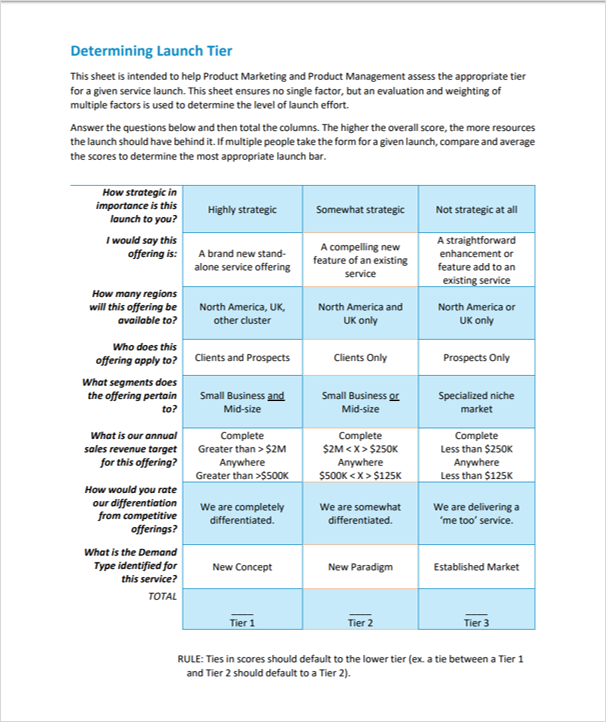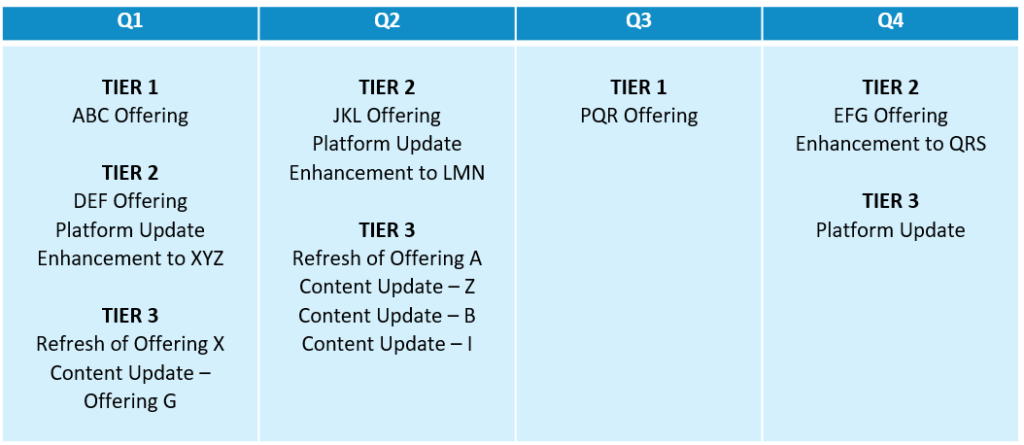Launch Tiers and How to Use the Launch Tier Form
Use a methodical and collaborative approach to determining the importance of and resources needed for a given launch.
I highly recommend that the Launch Tier Form be used with PLC core team members to determine the importance of a given new offering or enhancement. If you don’t have an established PLC process, you can still use this as it can be very useful even for Marketing teams to raise the profile and impact of launches. That’s how this worked for me and my team. I was asked to devise a better approach to launches by our VP of Sales and Marketing who felt that our go-to-market was inconsistent. This particular approach resulted in the company’s largest and most successful launch to date at that time. Of course, like I did, you’ll come to see how this is but one aspect of a larger PLC process and how your organization needs that too as your organization grows.
The Launch Tier Form:
- Helps you identify, in a more thought-through and deliberate way, what priority should be assigned to a given new offering or enhancement to an offering. Note: I talk about offerings here quite a bit though it’s entirely possible that you may launch something significant (ex. A new platform) that isn’t an offering at all.
- Aligns thinking across teams and leadership as to the importance or significance of a given offering. Helps to get their support behind the effort particularly when involving a Tier 1.
- Helps you to understand and dedicate a right-sized level of Marketing resources and effort.
I designed the Launch Tier Form to basically capture a number of perpsectives on the potential importance of a given offering. No one perspective dictates whether a new offering should be a major launch or not. It’s the combination of perspectives within the form as well as the comparative with Core Team members that determines the relative importance of an offering.
As you look to use this approach, you will want to modify the form to best fit your organization. For instance, your revenue targets will likely be different.

2-minute pre-work:
The Launch Tier Form references the Demand Type for a given offering. The Demand Type is based on a simple SiriusDecisions perspective on whether a launch regards something that is brand new to the market (New Concept) that solves a problem that many people don’t realize yet they have a problem for, New Paradigm which is best thought of as addressing a known problem or pain but through a better approach (think a ‘better mousetrap’) and Established Market which means that solutions to a problem or pain are well known and the market is mature. Pragmatic Marketing has a similar classification (“Pioneers,” “Settlers” and “Sheep”) of these three areas. I recommend Googling each of these.
Why I like the Demand Type is because it represents another important consideration for your new offering. For instance, if you determined that a given offering is “New Concept,” then you will want to ensure that resources be focused on educating the market as to the problem or pain and how to solve it. You might create a white paper or conduct a webinar that serves to expose and educate your targeted audience as to a problem they may have and not know it way before you just talk about your offering.
Be sure the team members who will be involved in filling out the Launch Tier Form understand Demand Types. Explaining them should only take a few minutes.

Here’s how to leverage the Launch Tier Form
- Get together the Core Team that includes you, the Product Marketing Manager, the Product Manager for the offering, and a Sales representative. Feel free to include additional core representatives. However, this should really include the Core Team only and not leaders who are on the edges of involvement.
- Provide copies of the form to each core team member to fill out for each project that will move through the PLC process that involves some type of external go-to-market or launch. The form should take no more than 5 minutes. Prioritize the list so that you can ensure you get to the likely most important projects first.
- Each team member should indicate their choice on each row of the sheet.
- Then, each team member should add up the choices they made in each column. This total will point toward which Launch Tier the offering falls into from their perspective.
- The team should then compare results. Sometimes, a new offering or enhancement will have a clear compelling result across the surveys. Other times, it may be necessary to talk through and arrive at a final consensus. Regardless, the form accelerates this arrival. As well, the form acts as documentation and validation for the decision made. This can be useful to show leadership how the Launch Tier was arrived at (and keeps leaders from trying to interject their opinion).
This is very important – If you arrive at the same score for a Tier 1 and Tier 2, ALWAYS default to the lower tier. A Tier 1 will involve lots of resources across Marketing and the organization at-large so the case for a Tier 1 should be clear through the form’s results. A tie should tell you that you have a less-than-worthy Tier 1. This is whether you as a Product Marketer are the only one responsible for determining the tier level (I don’t recommend that) or it’s the case across team members.
If you want, you can also tabulate totals for each row across the team members who filled it out to see the overalls strength of responses for a given area.
- After you’ve done this for each relevant project, now total up what you have in terms of Launch Tiers 1, 2 and 3 and when.
- Because Marketing teams as well as other go-to-market contributors can only handle a Tier 1 launch only two times per quarter at most (that may even be aggressive), you just want to be sure that your prioritization doesn’t create a situation where you have too many Tier 1s in a given quarter.

- Now, you have a roadmap of projects flowing through the PLC process and you have a measure of their overall importance and the resources that will need to be committed to it in the sense of the Launch Tier designation.
Now What the Hell Does Each Tier Mean?
A Tier 1 Launch is an all-hands on deck launch across the Marketing team. Nearly every team member will likely have a role to play in the launch’s success. That’s because a launch of this magnitude should have each team member discussing and agreeing to how they will support it. As well, because their should be a campaign that provides air cover (the campaign theme is something that can tie into the problem or pain the new offering solves), that means that there is ample opportunity for each Marketing team member to be involved.
- Tier 1 launch – New Offering – Full program launch
- AR and PR
- Account-based Marketing
- Campaign Air Cover
- Communication: internal and external
- Digital; web content
- Event Focus/Event Anchor
- Lead Gen/Demand Gen activities
- Marketing materials
- Partner Marketing
- Sales Tools and Training
A Tier 2 Launch will be an order of magnitude lower in commitment across the Marketing team. Though many of the same activities may be incorporated, the fact is that fewer will be. For instance, a Tier 1 Launch is likely to trigger a press release and related activity. A Tier 2 Launch very well may not be up to the occasion for a press release. In the end, the commitment from across Marketing is notably less which is commensurate with the nature of the Tier 2’s importance.
- Tier 2 launch – New or Enhanced Offering
- Account-based Marketing
- AR/PR
- Communication: internal and external
- Digital; web content
- Lead Gen/Demand Gen activities
- Marketing materials
- Partner Marketing
- Sales Tools and Training
A Tier 3 Launch represents a minimal Marketing commitment. In many cases, the Product Marketer and Product Manager collaborate on related content and don’t invoke other core team members as the Tier 3’s importance and required effort don’t justify it. There is very little engagement across other Marketing teams.
- Tier 3 launch – Enhancement to an Existing Offering, Content Refresh
- Communication: internal only
- Refresh Digital; web content
- Refresh Marketing materials
- Refresh Sales tools and Training (internal)
Getting to the Actual Marketing Launch Plan
To accelerate this effort, I recommend creating a PowerPoint or Excel template that captures all of the possibilities and sharing this to help the team accelerate their thinking on how they want to support the effort.
Check out our Tools in the Toolbox post for the spectrum of marketing channels and tools to help you in developing your marketing launch plan.
As a Product Marketer, David has successfully launched products, services, solutions and platforms across a number of disciplines in the technology industry. David’s passion for Product Marketing and his eye for seeing how Product Marketing can lead to even stronger business outcomes led him to bring his expertise and knowledge to Shoot the Curl Marketing.



